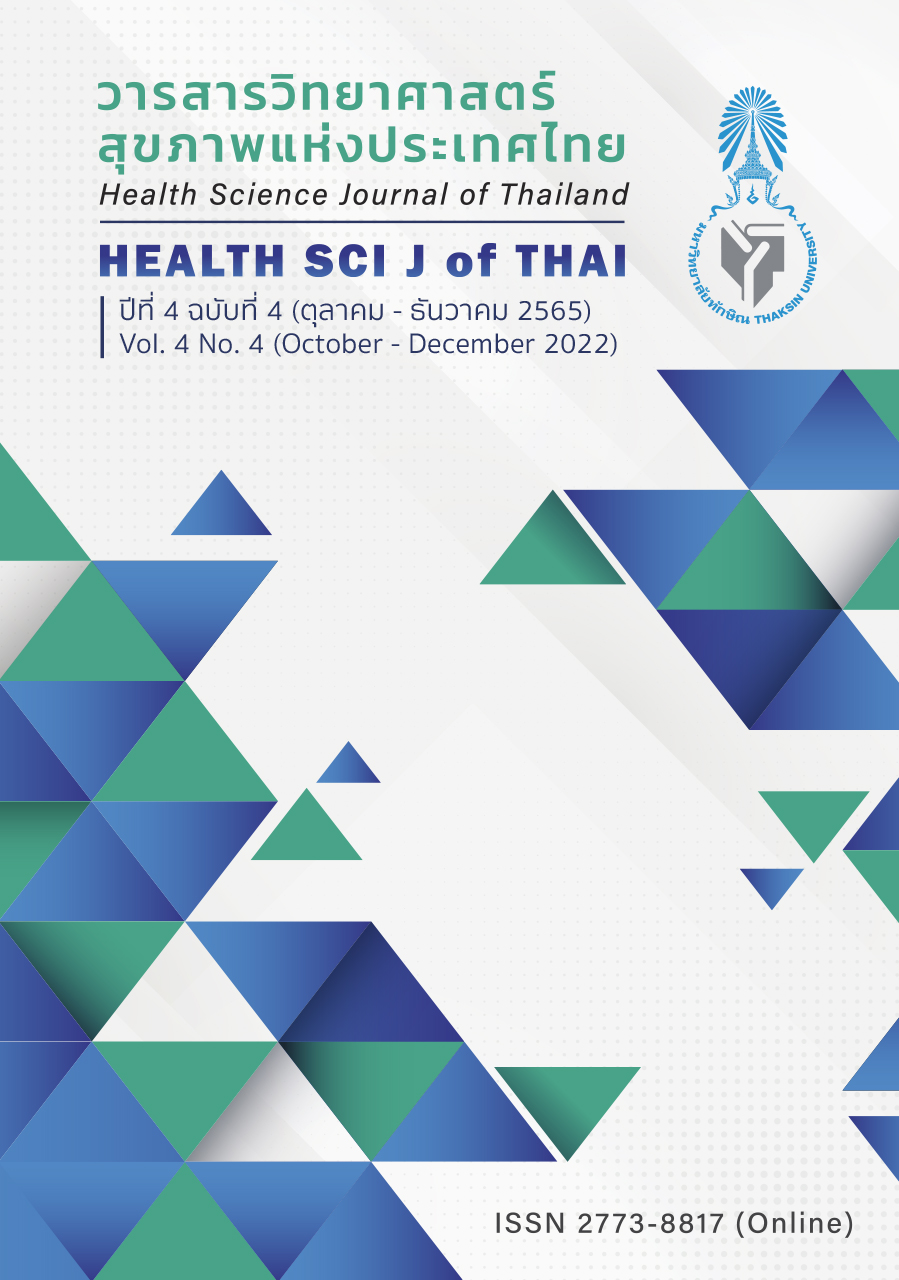Flowers on the Plate: Beauty Benefits and Risks
Main Article Content
Abstract
Nowadays, flowers are used as part of a dish for decoration or as raw food material for the reason that adding value and create a novelty to attract consumers to interest in the food item. However, the flowers themselves are found to be at risk of food insecurity such as toxins created by flowers themselves, heavy metals that flowers absorb from polluted environments, pesticides from growing flowers in the same area as other agricultural products, and contamination from soil microorganisms that the flowers grow. Moreover, the inability to wash flowers like other agricultural products will increase the risk of getting harmful from the flowers of the customers. Nevertheless, flowers are considered important sources of Phytochemicals such as Phenolic Compounds, Flavonoids, Carotenoids, and Anthocyanins. These phytochemicals can inhibit cancer cells, anti-inflammatory cells, and diabetes. Therefore, the consumers must consume flowers only from reliable sources such as organic planting and avoid consuming flowers from florist shops because there may be pesticide residues. In addition, to prevent problems with the digestive system and allergies, it is better to start consuming unknown flowers only for a small
Article Details

This work is licensed under a Creative Commons Attribution-NonCommercial-NoDerivatives 4.0 International License.
References
Rodriguesa H, Cielob DP, Goméz-Coronac C, Silveirab AAS, Marchesanb TA, Galmarinid, e MV, Richardsb NSPS. Eating flowers? Exploring attitudes and consumers' representation of edible flowers. Food Research International 2017; 100: 227-234.
Stratview Research. Edible Flower Market Report. [Internet]. 2019 [Cited in 6 August, 2022]. Available from: https://www.stratviewesearch.com/.
Technology Chaoban. Edible Flowers Business. [Internet]. 2022 [Cited in 6 August, 2022]. Available from: https://www.technologychaoban.com/bullet-news-today. (In Thai)
Falconnier D, Incredible Edible Flowers; University of Illinois Extension. USA: Urbana; 2006.
Roberts M, Edible & Medicinal Flowers. California: The Spearhead Press; 2000.
Knudsen L, Soborg I, Eriksen F, Pilegaard K, Pedersen J. Risk management and risk assessment of novel plant foods: Concepts and principles. Food and Chemical Toxicology 2008; 46(5): 1681-1705.
Rop O, Mlcek J, Jurikova T. Edible Flowers—A New Promising Source of Mineral Elements in Human Nutrition. Molecules 2012; 17(12): 6672–6683.
Flavia AG, Rezendea G, Sandeb D, Coelhob AC, Oliveirab MAD, Takahashib JA. Edible Flowers as Innovative Ingredients for Future Food Development: Anti-Alzheimer, Antimicrobial and Antioxidant Potential. Chemical Engineering Transactions 2019; 75: 337-342.
Zheng C, Dong O, Chen H, Cong O, Ding K. Structural characterization of a polysaccharide from Chrysanthemum morifolium flowers and its antioxidant activity. Carbohydrate Polymers 2015; 130(5): 113-121.
Zheng J, Yu X, Maninder M, Xu B. Total phenolics and antioxidants profiles of commonly consumed edible flowers in China. International Journal of Food Properties 2018; 21(1): 1524-1540.
Nanda B L. Antioxidant and Anticancer Activity of Edible Flowers. Journal of Drug Deliver and Therapeutics 2019; 9(3): 290-295.
Oun R, Moussa YE, Wheate NJ. The side effects of platinum-based chemotherapy drugs: a review for chemists. Dalton Transactions 2018; 19: 6645-6653.
Kim H, JiOh H, HwanKo J, Seongsong H, Geunlee Y, Chankang S, Younglee D, Inbaek N. Lanceoleins A–G, hydroxychalcones, from the flowers of Coreopsis lanceolate and their chemopreventive effects against human colon cancer cells. Bioorganic Chemistry 2019; 85: 274-281.
Lucarini M, Copetta A, Durazzo A, Gabrielli P, Lombardi-Boccia G, Lupotto E, Santini A, Ruffoni B. A Snapshot on Food Allergies: A Case Study on Edible Flowers. Sustainability 2020; 12: 1-24.
Rietjens I M C M, Martena M J, Boersma M G, Spiegelenberg W, Alink G M. Molecular mechanisms of toxicity of important food-borne phytotoxins. Mol. Nutr. Food Res 2005; 49: 131–158.
Egebjerg M M, Olesen PT, Eriksen FD, Ravn-Haren G, Bredsdorff L, Pilegaard K. Are wild And cultivated flowers served in restaurants or sold by local producers in Denmark safe for the consumer?. Food Chem Toxicol 2018; 120: 129–142.
Wetzel S, Lee J, Lee C S, Binkley M. Comparison of microbial diversity of edible flowers and basil grown with organic versus conventional methods. Can. J. Microbiol 2010; 56: 943–951.
Matyjaszczyk E, Schumann R. Cadmium contamination in food supplements containing white willow (Salix alba) bark. Journal of Consumer Protection and Food Safety 2018; 14: 179–182.
Tangmo S, Howhan S, Gothom P, Tuan NN, Sonmanee S, Yaemkong S. Analyses of Bioactive Ingredients and Pigments from Some Edible Flowers for Poultry Diets. Naresuan Agriculture Journal 2019; 16(1): 57-64. (In Thai)
Ounamornmas P, Sommano S. Analyses of Bioactive Ingredients and Antioxidant Activities of Some Edible Flowers. J of Agriculture 2016; 32(3): 435 – 445. (In Thai)
Yongqian L, Haung Y, Yang J, Liu Z, Li Y, Yao X, Wei B, Tang Z, Chen S, Liu D, Hu Z, Liu J, Meng Z, Nie S, Yang X. Bacteria and Poisonous Plants were the Primary Causative Hazards of Foodborne Disease Outbreak: a Seven-Year Survey from Guangxi, South China. BMC Public Health 2018; 18: 1-8.
Sriapha C, Tongpoo A, Wongvisavakorn S, Rittilert P, Trakulsrichai S, Srisuma S, Wananukul W. Plant Poisoning in Thailand: a 10-Year Analysis from Ramathibodi Poison Center. Southeast Asian J. Trop Med Public Health 2015; 46: 6.
Chamakuri SR, Suttee A, Mondal P. An Eye-catching and Comprehensive Review on Plumeria Pudica JACQ. Plant Archives 2020; 20(2): 2076-2079.
Fernandes L, Casal S, Pereira JA, Saraiva JA, Ramalhosa E. An Overview on the Market of Edible Flowers. Food Reviews International 2020; 36(3): 258-275.
Ministry of Public Health. The Food Act B.E. 2522: Tea Infusion. Notification of the Ministry of Public Health (No.426) 2022; 8-9.


